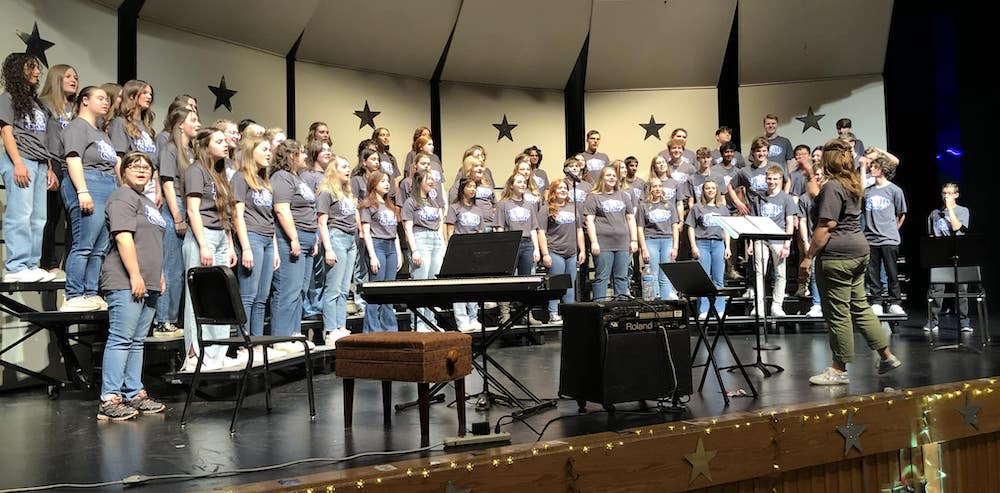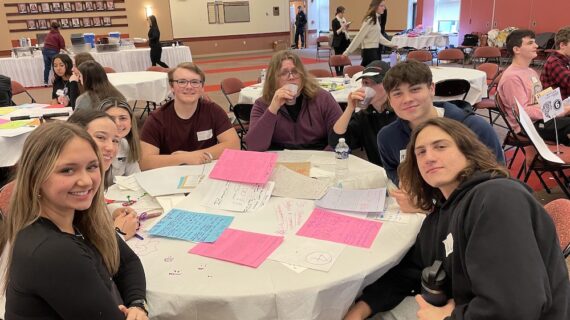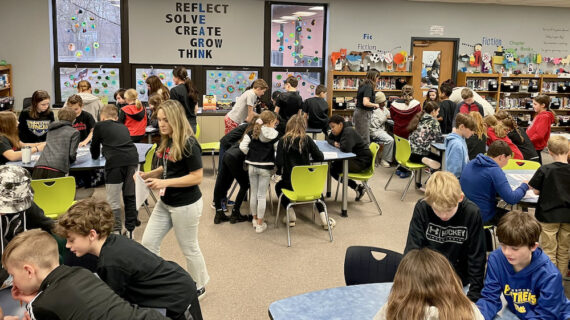
In the Franklin Regional School District, letting teachers take the lead
This story is one in a series created in collaboration with the AASA Learning 2025 Alliance to celebrate the work of groundbreaking school districts in the Pittsburgh region. Kidsburgh will share these stories throughout 2024.
Jennifer DiFulvio has seen the jokes on TikTok. It’s a time-honored tradition: teachers taking to social media to commiserate about lackluster professional development, known simply as “PD.”
“We’ve all been through it,” DiFulvio says, laughing. “There’s the typical PD model we see in lots of places — one where you’re sitting in a chair from 7:30 to 3, and you’re doing the exact same thing as everyone else, even if it’s not particularly meaningful or relevant to your role.”
In these cases, she says, “it’s hard not to think, ‘Well, we’re not supposed to teach kids this way, so why is it okay for educators?’”
Online jokes aside, the problem hints at something deeper that’s troubling school systems nationwide. One report, detailing why so many teachers are leaving the profession, notes that meaningful work is “by far the top reason that motivates teachers to stay.” When educators aren’t offered opportunities to develop and grow, they start looking elsewhere for the trust and respect they deserve.
“People ask why no one wants to be a teacher anymore,” says DiFulvio, assistant superintendent for student supports and elementary education at the Franklin Regional School District. “It’s because often, there’s no structure in place to support their growth. There’s no structure for creating community and building each other up. Here in Franklin Regional, we’ve set out to change that.”
Leaving behind the kind of PD that leads teachers to TikTok, Franklin Regional has instead developed a flexible, teacher-led approach to professional learning that trusts educators to design the best path forward for themselves and their students.
“It really begins with listening,” DiFulvio explains. “Rather than [administrators] telling teachers, ‘Here’s what you need to do,’ we’re asking our department heads to tell us what they need and how we can make it happen.”
The result, she says, has been “a burst of ideas and creativity,” along with a renewed sense of agency and trust. Empowered to make their own decisions about learning, teachers are dreaming up innovative projects and plans — and implementing those plans with support from the district.
This commitment to supporting teachers led Franklin Regional to join the Western Pennsylvania Learning 2025 Alliance, a regional cohort of school districts working together — with support from The Grable Foundation — to create student-centered, equity-focused, future-driven schools. Led by local superintendents and AASA, The School Superintendents Association, the Alliance convenes to help districts like Franklin Regional do what they do best: prepare every learner for tomorrow.
“Typically, districts operate in a silo,” says Ryan Smith, Franklin Regional’s director of instruction and support services. “But through the Alliance, we’re knocking down the walls of our ZIP codes. We’re reaching out to each other. We’re working collaboratively, not only for our own district but for the region as a whole. It’s been extremely powerful.”
And that’s exactly the kind of community that district officials are working to create with teachers. Franklin Regional’s secondary science and math departments, for example, are now working with internationally renowned consultants who visit the district, co-teach lessons, and help teachers develop their practice over time.
“Teachers really liked the idea of bringing these folks in for extended periods — say, 12 or 14 times over the course of a year,” says Matthew Delp, the district’s assistant superintendent for human resources and secondary education. “The consultants aren’t salespeople dropping off an idea. Instead, they’re people with teaching backgrounds who are here for the long haul, partnering with our staff to help with guidance and implementation. It’s been a really wonderful model.”
The district’s teachers agree.
“The feedback we’re getting is amazing,” says Delp. “They appreciate the trust we’re placing in them and the fact that we’re saying, ‘Hey, we believe in you. And we believe in your passion for teaching.’”
Students, too, are reaping the new model’s benefits. One learner in a math class noted that he and his peers had never talked about math as much as they did during a recent 40-minute lesson: “Not just learning math. Not just doing math. But talking about it, too. That’s a powerful thing.”
The district is even redesigning its physical spaces to reflect its commitment to creative, collaborative learning. Booths and high tabletops replace the walls of old lockers. What was once a typical hallway now resembles a cafe. “Kids aren’t used to that,” says Smith. “They’re used to sitting in rows and columns in a classroom. So, when we turn the hallways into these beautiful, collaborative spaces, it shifts their thinking. It brings out their creativity.”
It also adds to the sense of possibility that pervades Franklin Regional.
The momentum is palpable, officials say, and there’s lots more in the works — including a coaching and leadership program designed to help teachers and principals plot their professional careers.
“Whether you’re a classroom teacher or a principal or even an administrator in the central office, we all need the same thing,” explains Delp: “to support each other in our learning, and to take care of each other as a community. That’s why we invest in our people. And that’s how we move forward for kids.”
Want to download this story? Click here for a PDF.








